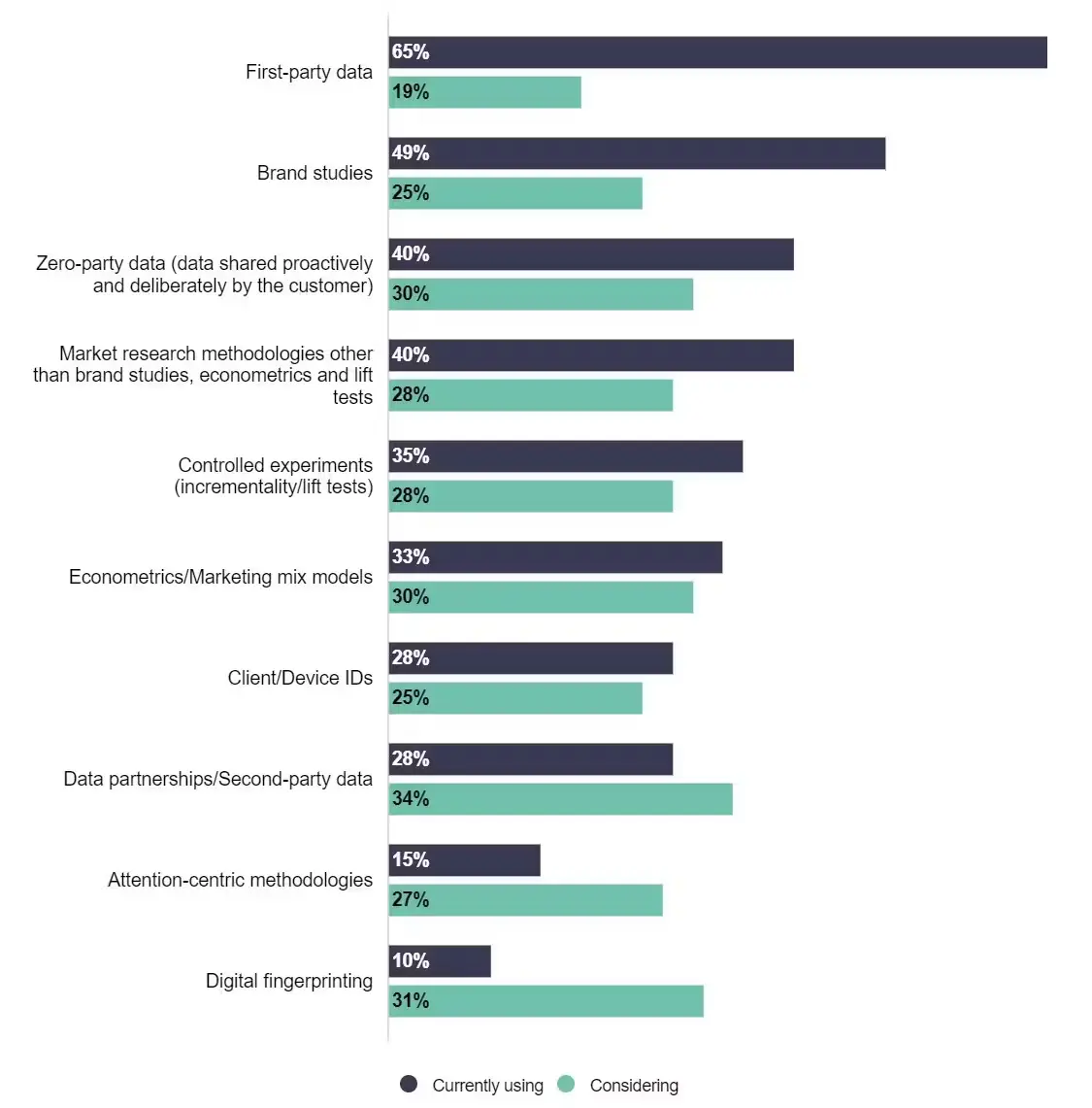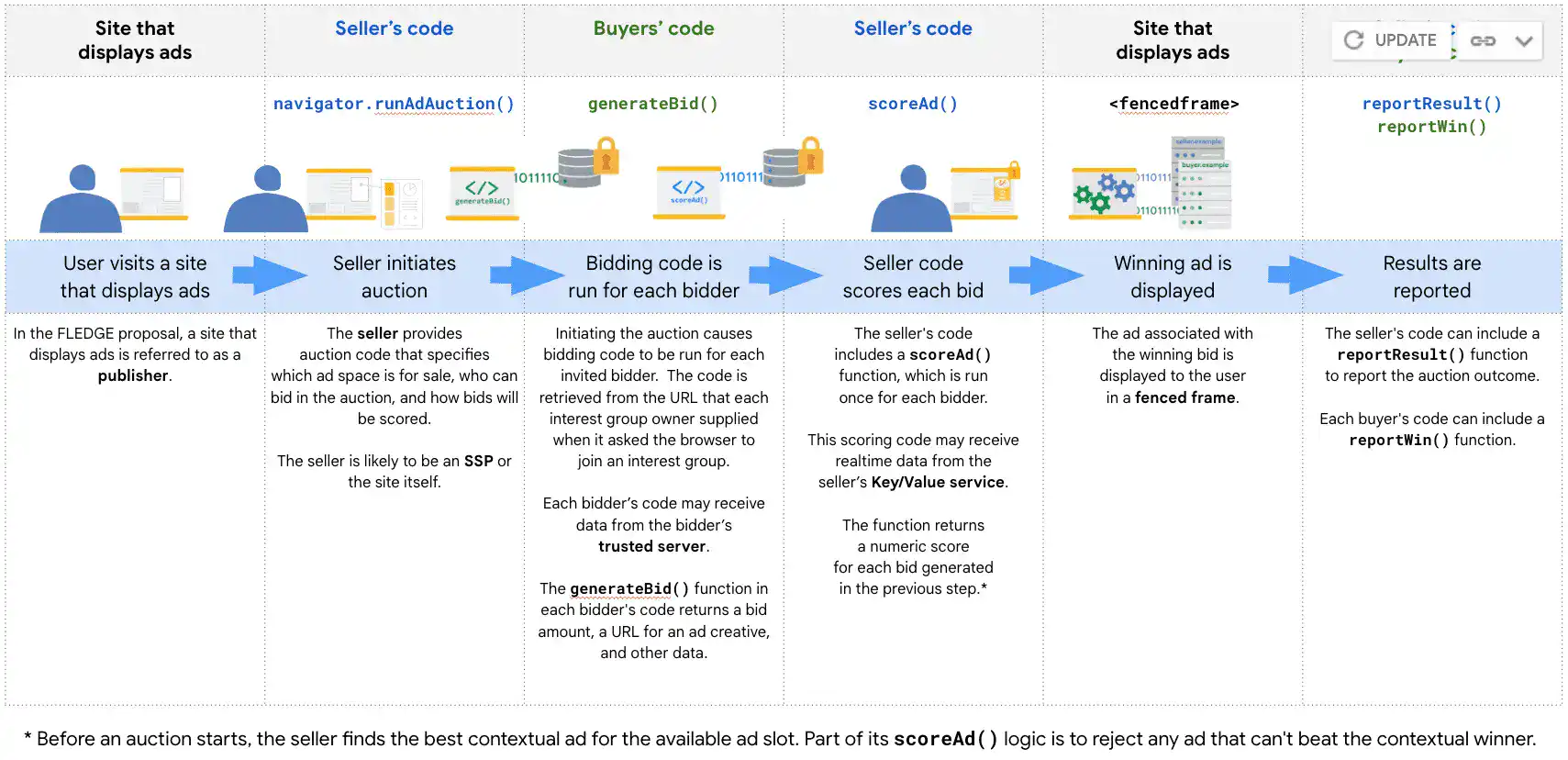Advertising without cookies is the talk of the media town!
Marketers are gearing up for it by armoring themselves with potential alternatives such as contextual targeting, first-party data, and building a reliable relationship with audiences.
Here is the list of alternatives marketers are considering to choose in 2024.

Undoubtedly, utilizing Privacy Sandbox for measurement and reporting will be on their checklist. Google is enabling more privacy-focused targeting with Privacy Sandbox and its Application Programming Interfaces (APIs).
One of these, Protected Audience API (PAAPI), is rethinking remarketing (behavioral targeting) with exceptional features and strengthening user privacy.
This blog shares an extensive guide on PAAPI, like why it is important, how it works in the media ecosystem, and the key concepts you need to understand.
So, let’s dive in.
Table of Contents
- What Is Protected Audience API?
- Why Is PAAPI Important?
- How Protected Audience API Works?
- PAAPI’s Key Concepts to Understand
- Do Advertisers Have the upper hand with PAAPI? What About Publishers?
- First-party Data Let Publishers Reign
- GAM Become a Top-level Seller for Publishers Who Utilize PAAPI
- Protected Audience API vs. Topics API
- Why Publishers and Advertisers Should Use PAAPI?
- When Did PAAPI Become Live?
- Redefining Remarketing!
What Is Protected Audience API?
The Protected Audience API is the Privacy Sandbox technology used for remarketing and delivering relevant ads and is designed to prevent third-party data tracking across sites.
The PAAPI enables on-device auction by the browser to choose the best relevant ads for the user with the website that the same user has previously visited.
FLEDGE (First “Locally-Executed Decision over Groups”) was the previous name of PAAPI when it was in the experiment stage. Later, it changed to PAAPI to clearly state that this API offers user data-safe, protected targeting.
Why Is PAAPI Important?
PAAPI is literally changing how remarketing has traditionally been done by keeping user privacy at the forefront. Hence, it became vital for publishers and advertisers to learn about it.
- PAAPI helps marketers target and show highly addressable ads depending on the site the users visited previously.
- It is a privacy-friendly API allowing adtech intermediaries to show relevant ads without cross-site tracking and reduce the dependency on third-party data.
- PAAPI enhances user experience through relevant ads, adding value to the website, such as increased traffic, ad viewability, and ad revenue.
- PAAPI is moving the web platform closer to the user’s browser, where the user data is stored in their device and browser but not shared in any way with publishers, advertisers, or adtech platforms during the auction.
- The information stored in the user browser is shared with marketers during an auction in a more concealed way called interest groups (about which we see later in the blog ) to heighten user privacy and simultaneously give publishers a way to make revenue from relevant ads.
How Protected Audience API Works?
PAAPI redefines remarketing with interest groups, enabling publishers to show relevant ads while protecting privacy.
The working of Protected Audience API revolves around interest groups.
- For instance, when a user visits a website that sells running shoes and adds it to the cart.
- The DSP associated with the site creates an interest group (for example: “running shoes”) and will ask the user to add membership to that group.
- After that, when the same user visits the publisher site that sells ad space (e.g., news website).
- The SSP associated with the site calls for the auction and sends the ad request to DSPs, the owners of interest groups the user is part of.
- The advertisers return the bid, SSP scores the bids and returns the winning ad to the ad server, and then it is rendered on the website.
Since it is an in-device auction, the bidding code and bid scoring logic are downloaded to the device, and the browser will run the auction and return the winning bid.

*Publishers can use Prebid to run multiple PAAPI auctions in conjunction with contextual auctions under the supervision of ad server Google Ad Manager.*
PAAPI’s Key Concepts to Understand
Interest Group
PAAPI’s interest group contains a group of people with common interests to be used in remarketing. Every PAAPI’s interest group has an owner who creates it for different user cases. The data in the interest group can be updated and enabled for up to 30 days.
For instance, when a user visits a website that wants to advertise its product and spends time searching for “Western dress.” The DSP corresponding to the website can create an interest group, “western wear,” and the DSP owns it.
The configuration information of the interest group allows the browser to access the bidding code, ad code, and real-time data to use in the auction when the owner of the interest group is invited to bid.
How is real-time data incorporated into the auction?
The PAAPI’s key/value service allows adtech platforms to access real-time data during the auction by sending properties of keys, and the key/value services return value for each key.
Sellers and buyers use that data to score the bid, see when the buyer makes the bid, or check the ad campaign budget spent.
Do Advertisers Have the upper hand with PAAPI? What About Publishers?
Behavioral targeting using PAAPI relies mostly on the advertiser’s interest group and the interest groups that the user is part of. In this process, publishers have no say except to initiate an ad auction by calling the JavaScript code.
Also, when you see the real-world testing of Privacy Sandbox APIs, for instance, Google Ads’s “Interesting-based advertising (IBA) experiment” tested combinations of privacy signals (contextual information, the TOPICS API, PAAPI, first-party identifiers) against third-party cookie efficiency.
The results reveal that the IBA test is privacy-focused and does not sacrifice performance for privacy. See the below findings of the test.
- Ad spend reduced by 2-7% in using Privacy Sandbox APIs
- Conversions per dollar reduced 1-3%
- Click-through rates stay the same irrespective of API usage.
This test and results show a reduction in ad spending by up to 7%, which means the advertisers can spend less with APIs. What does it have for publishers? Is it giving the signal that the publishers get less ad revenue?
PAAPI and other Privacy Sandbox APIs help publishers retarget, but the output efficiency of targeting for publishers is unknown.
Even though AdSense is actively testing the Privacy Sandbox APIs, it will report the test results to the Canadian Marketing Association (CMA) in Q2 2024. The test result findings may give a clearer view of the efficiency of Privacy Sandbox API (PAAPI) on the publisher side.
*CMA’s working group on Adtech responds to and regularizes the new changes in Adtechs.*
First-party Data Let Publishers Reign
Behavioral targeting using interest groups favors advertisers, while contextual targeting using granular first-party data lets publishers reign.
The big techs like Google, Amazon, and Facebook rule adtech with their data, which is the most reliable way for publishers to keep their seats.
Behavioral auctions using PAAPI and TOPICS API run in conjunction with contextual auctions. The base of the contextual auction is website content and the potential first-party data.
Also, interest groups are not exclusive to advertisers. Publishers can also create interest groups with their first-party data, which has more potential details of different user groups than the ones owned by advertisers.
These data include the articles the user reads, sections they focus on, and more nuanced information like finding user interest by calculating the time spent on the section.
Publishers can strengthen these data from general geolocation from the browser’s Topics API and GeoIP. Overall, first-party data amplifies the chance of you (as a publisher) wanting a high demand and CPM for your ad inventory and, thereby, ad revenue.
GAM Become a Top-level Seller for Publishers Who Utilize PAAPI
In PAAPI, the interest group data will not leave the browser; in contrast, the browser downloads all the bidding code and seller’s scoring logic to conduct the on-device auction. The JavaScript configures the auction, and that script knows the best available existing bid, often called contextual winner, but it is not.
93% of U.S. publishers use Google Ad Manager (GAM), and the bid it selects with the existing workflow is the contextual auction winner. GAM has a special feature (developed by Chrome at GAM’s request) that non-transparently passes the contextual auction result to its on-page JavaScript library.
The GAM will initiate the individual PAAPI auction, get the auction configuration through APIs, and then compare each PAAPI auction bid with contextual auction bids.
By design, the GAM can identify the best bid from contextual and PAAPI auctions. This feature is exclusive to GAM and is a kind of unified auction. So, the publisher who wishes to use PAAPI has no choice but to use GAM as their top-level seller.
Also, if a publisher wants to add AdWords to their PAAPI auction, they must choose GAM. AdWords is responsible for the vast PAAPI transactions, and its buying is restricted to one who uses Google Ad Exchange.
Protected Audience API vs. Topics API
Topics API is another element of Privacy Sandbox, which is similar to PAAPI. Topics API groups users based on their perceived interests to provide a way for publishers to target audience. But still, its way of grouping is different.
The Topics API groups users based on the fixed taxonomy and browsing history. It is designed to group some high-level information about the interests and is ideal only for upper-level funnel campaigns (brand awareness, interest, and desire). Topics API is more into preserving user privacy than targeting.
On the other hand, PAAPI is an advanced one that allows you to customize audiences with interest groups, which you can upgrade with other technologies in the cookieless world. If PAAPI is used correctly, it can be strengthened by the data from Topics API and other cookie-less standards. Targeting efficiency is high in PAAPI.
Overall, Topics API is not better or worse than PAAPI; it is just another tool publishers and advertisers use for custom audiences.
Why Publishers and Advertisers Should Use PAAPI?
- It is the new normal way to do remarketing without disturbing privacy
- You can customize your audience based on the interest groups.
- PAAPI ads are more efficient in showing highly addressable ads.
- Publishers have control over the bidding process with information like who they invited to bid and who are all returning bids. They can also access real-time data effectively during an auction.
- Rather than reporting on the event level, the Privacy Sandbox team will change it to attribution reporting API, which gives higher-level insights like which campaign contributed more conversions, how the particular user activity contributed to the end goal, etc.
- User experience can be greatly improved, eventually improving ad viewability and revenue.
- It adds extra revenue opportunities, increasing publishers’ ad revenue and yield. Advertiser can achieve high ROI from their campaigns.
When Did PAAPI Become Live?
Google has made the Privacy Sandbox APIs (including PAAPI) live for targeting and measurement in July 2023 so developers can do scaled testing before the complete phaseout of third-party cookies.
Before this announcement, Google tested the Privacy Sandbox APIs with the trusted group of adtech platforms. Criteo and RTB House are important adtech companies actively participating in the Privacy Sandbox testing from 2021.
GroupM announced an initiative in November 2023 that it will start testing Privacy Sandbox APIs with its trusted clients. The testing focuses on three Sandbox APIs: Topics, Protected Audience, and Attribution. This testing aims to find which technology makes more ad revenue: Privacy Sandbox APIs or third-party cookies.
Even though the adoption is lesser now, we can expect it to rise when Google keeps its timeline on destroying cookies step-by-step.
Redefining Remarketing!
As the media world evolves, it brings new privacy-focused advances and demands marketers to adapt to it.
PAAPI is the important Privacy Sandbox API that fills the one missing block in the cookiless world: Remarketing. It gives a hand for marketers to target more granular and relevant audiences by keeping user privacy on the front line.
The PAAPI’s workflow seems to streamline the remarketing better, and the Sandbox team will bring more promising features into the game.
Google is progressing with its timeline to shut down cookies. Still, it is not too late to adopt. Take the initiative to do Privacy Sandbox testing and find ways to work efficiently with it to deliver successful, future-ready, personalized ad serving and save your bottom line.























